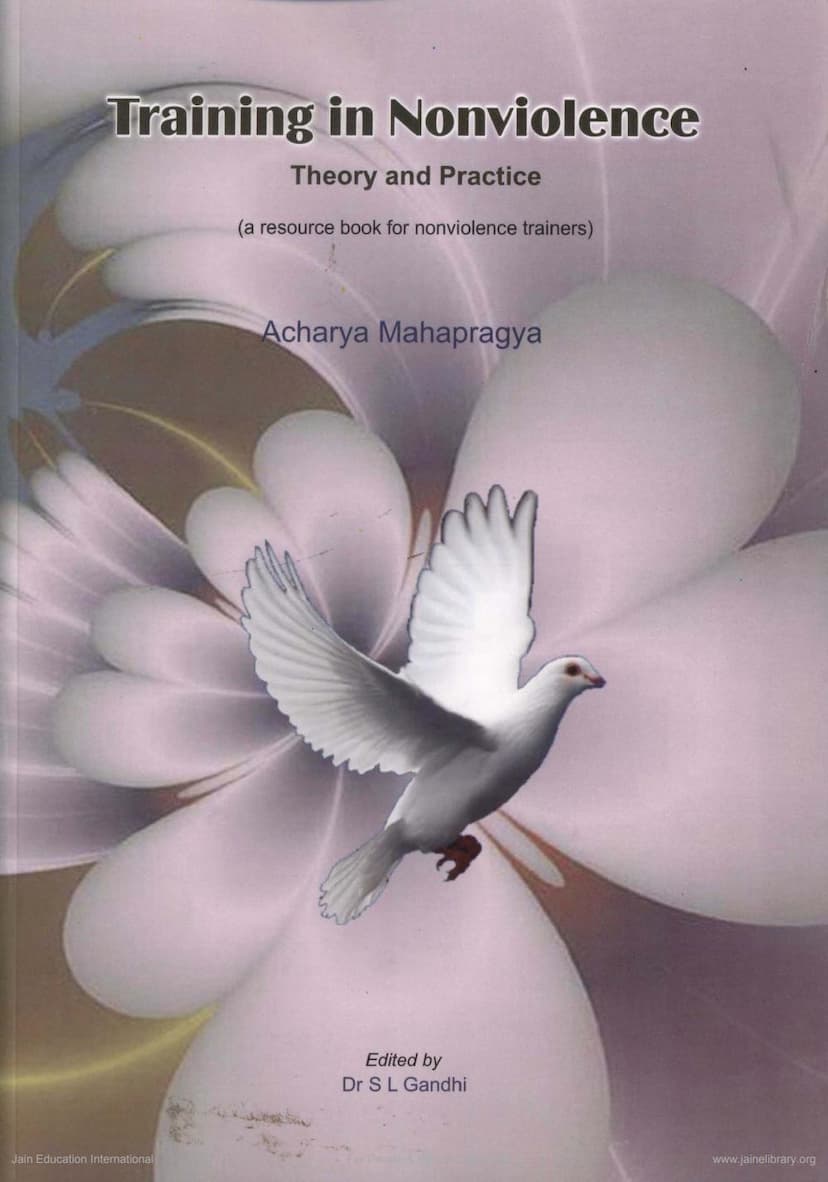Training In Nonviolence
Added to library: September 2, 2025

Summary
This comprehensive Jain text, "Training in Nonviolence: Theory and Practice" by Acharya Mahapragya, edited by Dr. S.L. Gandhi and published by Anuvrat Global Organization, serves as a resource for nonviolence trainers. The book emphasizes that nonviolence, or ahimsa, is not merely a concept but a way of life that requires systematic training.
Core Philosophy and Principles:
- Nonviolence as an Eternal Religion: Acharya Mahapragya presents ahimsa as a fundamental principle, not just a response to conflict. He argues that its independent development is hindered by its perception as a negative force or solely a means of self-extrication from difficult situations.
- The Interdependence of Life (Parasparopagraho Jivanam): Drawing from Jain cosmology and the teachings of Lord Mahavira, the book highlights the intrinsic connection between all living beings and the environment. This concept forms the basis of modern ecology and underscores the necessity of mutual support and accommodation.
- Non-Absolutism (Anekant) as an Antidote to Violence: The doctrine of anekant, which posits that truth has multiple facets, is presented as a crucial tool for reconciling differences and reducing violence. It promotes a balanced perspective that acknowledges both unity and diversity.
- Non-Possessiveness and Nonviolence: A key argument is that the consciousness of nonviolence stems from the consciousness of non-possessiveness. Greed, attachment to wealth, and excessive consumption are identified as root causes of violence.
- Transformation of Consciousness: The book stresses that societal problems, including violence, are rooted in the human mind and consciousness. Therefore, transforming individual consciousness through systematic training is essential for achieving universal peace.
The Need for Training:
- Overcoming Violence's Roots: Violence originates from inner impulses and external circumstances like hunger, poverty, and societal inequalities. Acharya Mahapragya argues that merely addressing external issues is insufficient; inner transformation is paramount.
- Activating the Right Brain Hemisphere: The author posits that the left hemisphere of the brain, associated with logic and analysis, is overly active in modern society, contributing to violence. The right hemisphere, responsible for intuition, empathy, and higher values, needs to be activated through specific training.
- Beyond Theory: The book critiques approaches to nonviolence training that focus solely on theory and lectures. It emphasizes the critical role of practical exercises and a "change of heart" for genuine attitudinal transformation.
Components of Nonviolence Training:
The book outlines a comprehensive approach to nonviolence training, encompassing:
- Theory and History of Nonviolence: Understanding various forms of violence, their roots, and the historical development of nonviolent traditions across different religions and movements.
- Transformation of the Heart: This is considered the most crucial part, involving the development of qualities like:
- Self-discipline and control of impulsive behavior
- Fearlessness
- Tolerance
- Compassion
- Humility
- The book suggests practices like Kayotsarg (deep relaxation), perception of breathing, and meditation on psychic centers.
- Nonviolent Lifestyle: Adopting principles such as:
- Abstinence from unnecessary violence and aggression.
- Faith in human solidarity and religious tolerance.
- Rectitude, honesty, and self-restraint in daily dealings.
- Limiting acquisition and consumption.
- Dignity of work and simple living.
- Right Means of Livelihood and Training in Self-Employment: Addressing economic imbalances and unemployment as significant contributors to violence. The emphasis is on ethical economic practices, fair means of earning, and self-reliance.
Practical Strategies and Exercises:
The book provides concrete strategies and practical exercises for trainers and trainees, including:
- Sevenfold Strategy: Training trainers, organizing camps, symposia, seminars, workshops, conferences, and integrating nonviolence training into children's education.
- Tools for Nonviolence Training: Developing a conceptual understanding of balanced development and a correct outlook on wealth, encompassing emotional development, spiritual and moral growth, a nonviolent lifestyle, and holistic health.
- Attitudinal Transformation Exercises: Practical exercises involving affirmations, visualizations, breathing techniques (pranayama), and contemplative meditations (anupreksha) to cultivate specific virtues like balanced development, nonviolent lifestyle, emotional development, restraint in consumption, fearlessness, compassion, and tolerance.
Overall Message:
"Training in Nonviolence" by Acharya Mahapragya advocates for a holistic and practical approach to cultivating nonviolence, starting from the individual and extending to society. It emphasizes that true nonviolence arises from inner transformation, a balanced lifestyle, and a deep respect for all life forms, rooted in the profound Jain philosophy of anekant and the interconnectedness of all existence. The book serves as a guide for fostering a more peaceful and harmonious world.